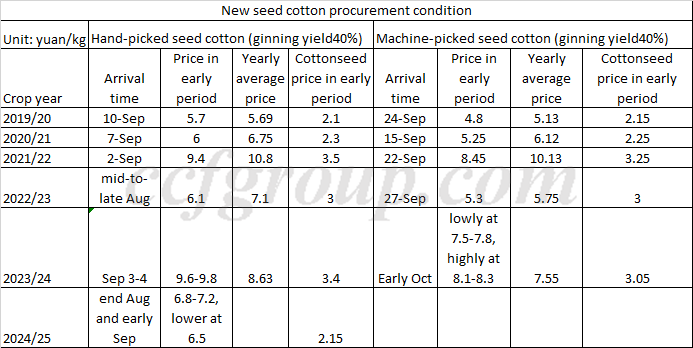Divergences of ZCE cotton with coming seed cotton procurement
After entering Sep, the volatility of ZCE cotton futures has noticeably increased. The performance in the first four trading days has been characterized by a significant drop on the previous day, followed by a rapid recovery the next day. On Sep 2 and Sep 4, the sharp declines in commodity indices and the overall negative atmosphere in the commodity market contributed to the drop in ZCE cotton. Additionally, during the night sessions of Sep 2 and Sep 3, the long positions increased largely, driving up ZCE cotton. Besides, there were rumors that the government might reserve 1 million tons of cotton into warehouse. This indicates that there are large divergences on the market and the competition among funds is quite evident. Excluding the influence of fund sentiment, what are the divergences affecting ZCE cotton from the perspective of the fundamental?
Firstly, in terms of downstream consumption, the industry downstream market started to improve month-on-month from Aug. In the first half of Aug, the improvement was mainly observed in the grey fabric sector, which had not yet transmitted to the cotton yarn sector. By late Aug, the improvement began to be transmitted to the cotton yarn sector. In Aug, the operating rate of spinning mills and fabric mills gradually increased, and product inventories decreased. By early Sep, there were signs of weakening in some grey fabric markets, such as in Guangdong, where fabric mills' operating rate slightly declined. However, markets like Lanxi still performed relatively well, though mills reported poor profits. As of now, downstream spinners are still able to maintain sales, and the weakening of the grey fabric sector has not yet transmitted to the cotton yarn market. Overall, in the short term, the situation in the downstream industry provides some support for cotton prices, but the driving force is limited. Confidence among downstream mills remains insufficient, and the outlook for sustained improvement is not optimistic.
On the supply side, the main issue is with the new cotton. The overall production is expected to increase compared to the previous season, but there are still differences in market expectations regarding the extent of the production increase. Some conservative estimates suggest that the production of new cotton in Xinjiang will be around 5.7 million tons, an increase of less than 200,000 tons from the previous season, while some expect the production to be around 6 million tons, with an increase of nearly 500,000 tons or more. Another major point of contention is the purchasing price of new cotton. New machine-picked seed cotton is expected to be available for purchase in late Sept early Oct, but there are already mainstream expectations. Currently, the expected purchase price for machine-picked seed cotton is pessimistically around 5.5yuan/kg or below, while more optimistic estimates are around 6yuan/kg. Given that ginning factories experienced significant losses in the 2021/22 and 2023/24 seasons, their overall purchasing attitude is cautious. According to market news, related bank loan policies are also strictly controlled. In previous years, hand-picked seed cotton would start being purchased at the end of Aug or early Sep. This year, with many ginners yet to announce their prices, many have also yet to start purchasing. However, based on the few transactions from late Aug to now, with prices around 6.5–7.2yuan/kg and the historical price difference between machine-picked and hand-picked seed cotton, the expected purchase price for seed cotton in the 2024/25 season is closer to the 2020/21 and 2022/23 seasons. The probability of the machine-picked seed cotton purchase price being around or below 6yuan/kg is relatively high. Within the current mainstream market expectations, if the purchase price is 6yuan/kg and cottonseed price is 2yuan/kg, the cost of new cotton is around 14,300yuan/mt. Therefore, if the price of machine-picked seed cotton is below 6yuan/kg by the end of Sep, the futures market will face strong pressure. Conversely, if the purchase price exceeds 6yuan/kg, the pressure on the market will ease.

Therefore, from a fundamental perspective, although the operating rate of fabric mills in Guangdong declines slightly at the beginning of Sep and there are some signs of weakening in the grey fabric sector, the cotton yarn sector is still able to maintain sales. This provides some support for cotton prices, but the driving force is limited. Besides, from the market situation, machine-picked seed cotton prices are very likely to be at 6yuan/kg and below. This expectation creates noticeable pressure on cotton prices. However, this pressure is currently mainly based on expectations, and the actual pressure will depend on the purchase prices set by ginning factories for machine-picked seed cotton at the end of Sep or early Oct.
- Top keywords
- Cotton Price
- Cotton Futures Price
- Cotton Futures
- CZCE
- PTA Futures Price
- Chemical Fiber
- Polyester Prices
- Wool price
- PTA Futures
- Shengze Silk
- China
- Yarn Price
- price
- China Textile City
- Fibre Price
- Benzene Price
- Cotton
- Index
- Cotton Index
- PTA
- fabric price
- NYMEX
- Top 10
- textile industry
- Spot Cotton
- Cotton Yarn
- Polyester Price
- Futures
- PTA Price
- cotton yarn price

